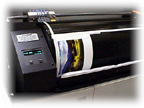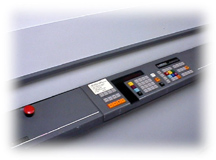Giclée is a limited edition
fine art print, produced with continuous tone ink jet technology
on a variety of substrates, most commonly watercolor paper and
canvas. Giclées are an exciting new medium for both artists
and photographers. Reasons for the excitement vary, but the
theme remains the same: quality. Whether reproducing an original,
enhancing a photo or painting, or creating original digital
art, giclées have much to offer. Sales statistics for giclée
prints have shown a 60% increase from 1996 to 1997 and the amount
spent by collectors in 1997 was $160 million.
 |
Giclée prints have the look
and feel of an original piece of art: Producing a giclée
print is a slow, meticulous process which requires the skills
of a master printer to create museum quality reproductions.
The technology calls for special equipment and techniques to
get the best color accuracy, sharpness, continuous color tone
and artistic interpretation available in art prints today. Because
giclée technology allows the image to be stored on disk, the
artist has the choice of printing an edition on an "as needed"
basis or all at one time.
 |
Giclée prints offer artists
photographers a new way to market their images: Giclées
are the wave of the future.They are affordable, particularly
compared to lithographs or serigraphs, and giclées
can produce more vibrant color on a wider variety of substrates.
Printed on watercolor paper, a photographic image takes on a
more painterly quality with softer edges and muted tones. Certain
photographs reproduced as giclées are mistaken for artwork and
many times a giclée reproduction cannot be distinguished from
the original.
Giclée prints are widely accepted at museums and galleries:
Dozens of museums in the U.S. and abroad have either mounted
exhibitions of Giclées or purchased them for their permanent
collections.These include the Metropolitan Museum (New York),
the Guggenheim (New York), the Museum of Fine Arts (Boston),
the Philadelphia Museum, the National Gallery for Women in the
Arts (DC) and the CaliforniaMuseum of Photography, among others.
The Smithsonian Institution will also be reproducing many of
its vintage photographs as giclées in a new agreement with the
Graphic Trust.
Many distinguished artists and
photographers are having Giclées printed, including Andrew Wyeth,
Jamie Wyeth, David Hockney, Chuck Close, Stephen Johnson, Joyce
Tennyson and Richard Avedon, to mention a few.We are a fine
art digital studio utilizing state of the art equipment to reproduce
your fine art.
Why is Giclee´
printing the way of the
future? The apparent
resolution of the digital print is
1,800 dots per inch, which is higher than a traditional lithographic
print and has a wider range of
color than serigraphy. Giclee´ prints render deep saturated
colors and have a beautiful painterly quality that retains minute
detail, subtle tints and blends.
|



